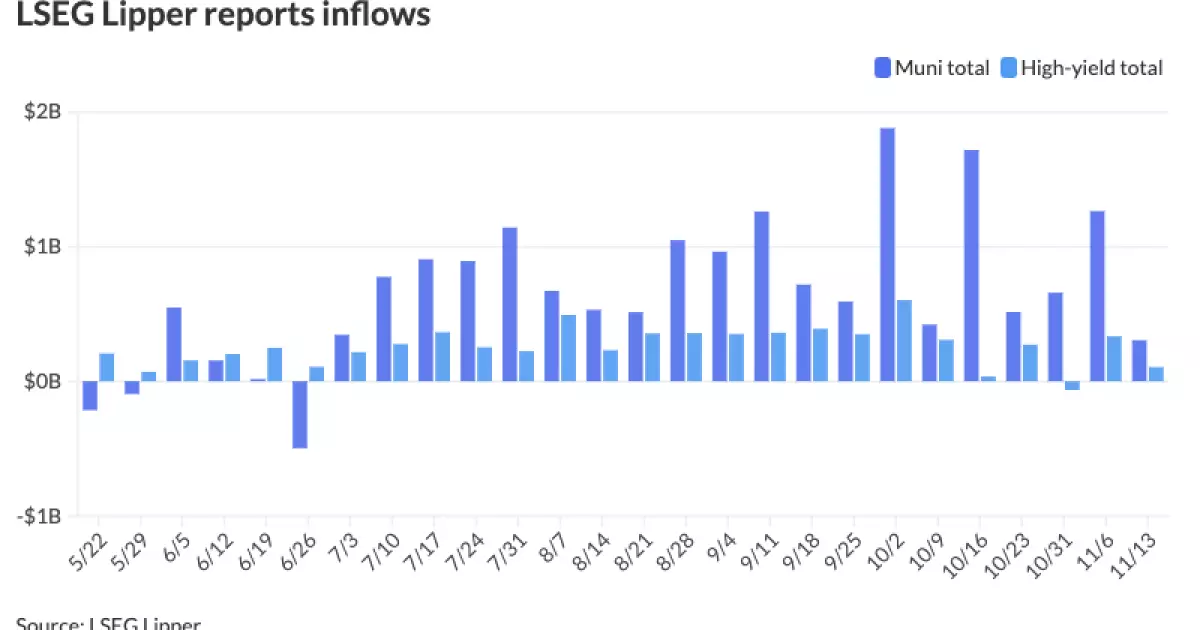Current Trends in the Municipal Bond Market: Analysis and Insights

The municipal bond market has exhibited mixed sentiments recently, reflecting broader volatility in the financial landscape. As U.S. Treasury securities experienced fluctuations—losses at shorter durations and gains in longer maturities—municipal yields also saw slight adjustments. During a relatively quiet week following the heightened volatility that often accompanies election outcomes, yields in the municipal sector fluctuated, adapting to the prevailing environment of uncertainty and economic transition.
A crucial focus of many analysts, including BlackRock strategists, is the impact of recent elections and the ongoing expectations surrounding Federal Reserve policy decisions. These factors are anticipated to keep volatility levels high, underscoring the importance of monitoring both political developments and monetary policy shifts in the coming weeks. Insights shared by fixed income portfolio managers, such as Kim Olsan from NewSquare Capital, draw parallels between the current market scenario and the volatility witnessed in November 2016, indicating that recent fluctuations are not entirely devoid of historical context.
Municipal yields have been primarily influenced by U.S. Treasury yields, and as such, the relative value between different maturities remains a significant consideration for investors. The range of yields for various maturities indicates underlying trends; for instance, Olsan’s observation regarding the scarcity of 3.00%-yielding municipal bonds between 2026 and 2032 highlights critical gaps where investor demand may shift. As a benchmark, the ratios of municipal yields to U.S. Treasury yields have declined, further stressing the notion that investors may begin reevaluating their positions in response to changing dynamics.
According to Refinitiv Municipal Market Data, the ratios for municipal bonds against U.S. Treasuries demonstrate how the market is recalibrating itself with respect to recent yield corrections. With the two-year ratio at 61% and the 30-year at 82%, we can see varying levels of attractiveness across the maturity spectrum. This disparity suggests that while certain maturities may offer enticing yields, investor appetite must be considered in a context marked by anticipated supply increases toward the end of 2024.
Supply and Demand Factors Shaping the Market
As municipal bond issuance typically peaks in the latter months of the year, trends observed in November and December pose important questions for future market dynamics. Historical data points to an average issuance of around $60 billion during these months, though significant outliers have affected this average markedly in certain years due to various macroeconomic conditions.
The current environment indicates that while oversupply may exert downward pressure on yields, diminished issuance could provide essential support as investors navigate through the complexities of the current market. Notably, factors such as daily bid list performance and fund flows might signal shifts in investor sentiment, contributing to potential yield pressures if the balance of demand and supply tips unfavorably.
Olsan remarks that the ongoing inflows observed at municipal bond mutual funds might taper off, capturing the more cautious market sentiment as they move closer to year-end portfolio configurations. Even though high-yield funds still attracted investor attention, the prevailing bearish trend indicates a sensitive phase for municipal bonds, pointing to contestable ground for both newer and seasoned investors alike.
Recent primary market activities illustrate the varied approach of municipal bond issuers in a complex yield environment. For instance, the Los Angeles Department of Water and Power priced significant power system revenue refunding bonds, showcasing a range from 2.40% for 2028 notes to 3.81% for 2054 bonds. Additionally, other issuers like the Omaha Public Power District navigated similar yield challenges in their electric system revenue bonds.
These transactions not only reflect issuer strategies in responding to market conditions but also offer insights into potential investor strategies. The variability seen in callable bonds draws attention to the risk-reward dynamic inherent in longer-term investments, especially when coupled with the current premise of rising inflation and monetary tightening.
As we advance through the final months of the year, the municipal bond market’s future trajectory is intertwined with both external economic variables and internal market sentiment. Understanding the intricate interplay of supply and demand, particularly in the face of evolving investor preferences, is crucial in anticipating the yield landscape.
Investors are urged to remain cognizant of market fluctuations and the underlying factors contributing to changes in yield dynamics. Insights drawn from primary market transactions reaffirm the necessity of a robust strategy that considers both current market conditions and historical trends. In this rapidly changing environment, adaptability will be key for those looking to leverage opportunities in the municipal bond sector.





